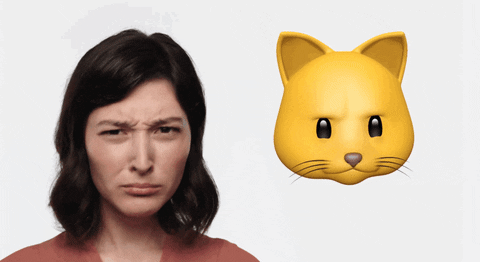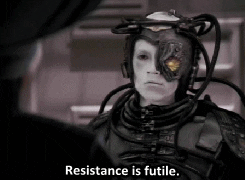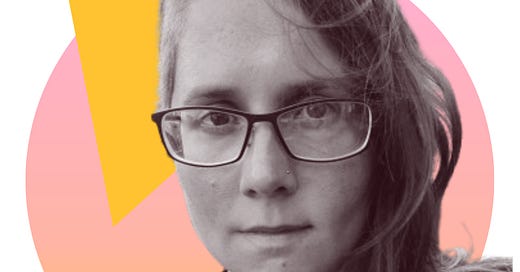🦾 The Future of Tech is Inclusive: An Interview with Amber Lundy
I interviewed Amber Lundy, Senior Designer at Amazon's UX Lab, a design incubation center focused on emerging tech (13 min read)
Homescreens is a publication about how we interact with our most intimate possession, our phones. Each week I interview founders and creators across industries and we reflect on the apps they use, how they’re organized, and their philosophy on notifications and mindfulness.

Amber’s childhood was likely different than yours or mine. Her father was the Global Executive Director of Engineering for Mattel, and as a kid she bounced around the world depending on which factory he was setting up and tooling. He was responsible for the engineering of Mattel toys during the ’80s and ‘90s — the golden era — which included Hot Wheels, Barbie, and Cabbage Patch Kids. Amber lived out every child’s dream: wandering toy factories and getting to play with new prototypes, something Amber credits as likely influencing her future career in tech.
After moving back to the U.S., Amber didn’t settle into the life of your average kid. She found it difficult to understand other kids her age and struggled to make friends. So, she went online to find others that shared similar interests to hers.
At one point in high school, Amber had six servers in her room, Linux and BSD machines, a mail server, and her own e-zine that featured a hacker hamster comic. Typical high school stuff, right? After running into some trouble, a judge told her to “do something useful instead of hacking around on computers all the time.” So, Amber ended up going to college and finding an industrial design program that allowed her to design consumer electronics — arguably the “toys” of the modern-day.
Here at college, more and more of the things Amber designed contained a screen or an interface, and it was her professors that nudged her towards what was then an emerging thing called UX design. From here, I’ll let Amber tell her story. What follows is our interview, edited for length and clarity.
Give me the background of what you’ve done and where you are now. Not many people can say they’ve worked for two of the A’s in FAANG.
Yeah, so I got an internship at Raytheon Websense [now Forcepoint] where I learned the basis of my UX methodology from people who had a Ph.D. in human-computer interaction. So from there, things just kind of took off. Some of the engineers I worked with in the security labs recruited me into a startup, Emotient Analytics, that had a sentiment analysis classifier that was interpreting human emotion in real-time through a video feed. We productized that, and it eventually got bought by Apple and turned into Face ID and Animojis.

So, all of them went to Apple and I went to Amazon because I wasn't really interested in staying, I had some pretty poor management, so I was already saying — I'm out of here. So I went to Amazon. At one point, I was working on some Alexa stuff for people with disabilities, and Apple reached out to me and said, “Hey, we have this role that's focused on inclusive design and creating products for people with disabilities.” And I was like — oh, that's interesting. I had been curious about how things were going at Apple because most of my friends from the startup hadn't left. So I took them up on their offer and I joined Apple.
Unfortunately, I didn’t have a super great experience, and I wanted to move to a better community. I felt like I kept dragging my husband around to different tech centers and we never had a community — there were no friends or family around, we just kept moving to different jobs. He was from Orchard Park originally, and I kept seeing 43 North, Z80 Labs, Techstars, and all of these tech things moving into the area. I loved the idea of getting in on something that was growing and becoming a bigger scene, rather than what I found in Cupertino which seemed kind of stale and transient. So, I reached out to Amazon and said — hey, I would love to come back remote. I’m moving to New York regardless, and I’m leaving Apple, so if you guys are interested, let me know — and they were like “yes! we’re totally interested in bringing you back!” So I came back.
So, when I came back I did some work on a heavy analytics platform, then the people at the UX lab remembered my lightning talks about body hacking and sensory design, so now I’m back at the UX lab at Amazon, and it feels like a really great fit, I feel super fortunate. It’s a long story [laughs] but that’s the gist of it.
No that’s great, it’s a great story. Could you explain what body hacking is? That’s a new term for me.
To me, it's about extending the senses and human capabilities through integrating with technology, almost like a cyborg survival kind of sense. Depending on your interpretation of history and how humans have adapted with tools, one could argue that we're already cyborgs.

Most everybody living in an urban environment and post-industrial society is heavily integrated with technology, in a way that we end up hacking into our bodies and integrating in different ways, and some people take that even further, so there's a lot of new senses being born.
I don't know if you've seen any work from Neil Harbisson who's able to hear color. There's basically this process in the human brain that relies on synesthesia, or the ability to cross the senses and reinterpret things. It's the same thing that blind and low vision people may rely on if they can't see, but they can tell if there's a leather sofa right over there because of the way the light is reverberating off of the material itself.
One of the aspects of body hacking I'm interested in is that kind of synesthetic effect: to switch the sensory abilities of the body using different technology integrations, like haptic feedback wearables that tell you where north is all the time — there's all kinds of crazy stuff. Or subdermal implants, I've got a subdermal near field transponder, but it's not super useful right now.
I saw you recently got your certification in UX design principles for AR and VR, how does UX design apply to AR and VR applications? I’ve heard it referred to as a “non-command interface” because you’re not clicking or typing anything, the computer is reacting to the environment.
There's a lot more computer perception involved in the interaction. Computers are interpreting our gestures, or our sentiment, or our gaze, and interactions with a three-dimensional space that doesn't necessarily exist, but the computer knows it exists. So it can place your body in that space and then the interaction design elements become much more skeuomorphic and relative to physical space, but not necessarily a literal interpretation of physical space. But in order for people to understand it, it's typically more skeuomorphic so they can draw that analogy and understand it easily. A lot of the UX involved in that space is much more on the human-to-machine design as opposed to just straight-up GUI.
Great answer! Skipping ahead to your phone, you have Wayfair. Is this because of their AR functionality or are you just using it for shopping?
[laughs] I think I went on and tried their AR app after I saw that it launched, but I was actually just using it for shopping after we moved here.

I see one app that I’ve never heard of, but I feel like I should have heard of it before — Amazon Chime. I did a quick search and it looks like an Amazon competitor to Zoom or Microsoft Teams. Is this what you use to work remotely at Amazon?
Yeah, that's been the main go-to chat client for Amazon for a long time. But, we recently got our own secure Slack instance for the corporate environment, so people are using that less. It's got a nice video calling feature which is good and it's integrated with our internal calendars for the most part, so you can start a Chime meeting and it's super easy. But yeah, it's kind of our internal tool that got externalized.
From the screenshots in the App Store, it looks like participants are connected through Echo Devices, is that possible?
Yeah! You can have a video call through your Echo Show, or you can hear a call through the standard Echo. I think the video integration through the multimodal device is super handy. I have 12 of them around the house now, but I only have that many because of testing.
Another app I wanted to ask you about is PictureThis. It looks like something I’d have totally used when we moved into our house and had all these flowers that I didn’t know what they were.
It's been pretty good for me at cataloging all of the plants and stuff that we have. I have a huge gardening habit, so it's been super useful identifying all the different trees and stuff that were already growing in our yard. It's pretty accurate. I did notice, depending on the part of the growth cycle of the plant, it'll give you completely different results. I'll go back every once in a while. I’ve got one plant that I had growing in my basement over winter, and it was like, “that's a poisonous blah, blah, blah.” Now, it said it was a red elm tree or something. But I definitely love that app, and I actually purchased it, which I rarely do.
We have Pinterest right there, what kind of boards do you follow?
I’ve created a lot of boards that I’ve ended up sharing. I’ve got one about composting, a bathroom remodeling board, deck remodeling board, an aquaponics one, female leaders, home ideas, business ideas, leadership…then there’s some stuff I did for a fashion design certificate I took a while ago. I created a kind of mood board for neo-office-femme, which actually has taken off this year. I created this two years ago, it’s basically doing fashion design with data-centered patterns, and integrating serious data science artifacts into the pattern and the fabric.
Wow, that is very cool. Tell me about this other app, Slide AR. Have you made any artwork with it?
I was supposed to for the class I was taking, but I don't see any of my prototypes, so I guess I never uploaded them. That was something I had installed for a class that I was taking for rapid prototyping and testing.
Where do you see AR and VR really hitting the mainstream, do you see it being integrated into more mainstream apps?
I don't think it's really going to get heavily adopted until there's a very portable and affordable form factor, like glasses, for example, where you have an extended reality with an informational overlay. Otherwise, use cases are pretty focused on entertainment or job-related specific functions, which isn't wide-level adoption for the general population. So until it's integrated into glasses and surfaces information easier and faster for us on top of everything else that we're doing, it's not going to be well-adopted for a while.

I feel like every few years there's a big hype about AR/VR going mainstream.
There's some interesting stuff happening in the entertainment and arts realm, which looking historically at technology, once something is getting heavily adopted in the art space by people who aren't necessarily technology practitioners, that's a pretty good signal that it's kind of slow-rolling it's way to consumer products.
This app that you have, Sunu, it looks like it has an exercise band like a Whoop band or Apple Watch. Is this a competing platform?
There may be some features and crossover, but this band was developed for blind and low vision people to get haptic feedback, and basically sonar as an extended sense in front of them. It's got this little detector on the front of it that shoots out the audio. Then there's actually a touch interface along the top and the side, so it's gotten different gestural inputs on it. You can tell time, you can have calendar integration, it gives you updates from your smartphone — it's super interesting. I got it to audit some of the features while I was doing some other inclusive design work. I should be wearing it more often to kind of get into that mind space.
I want to ask you about Loopfire, is this a super top-secret Amazon app? I see it’s in Testflight.
It’s not a super top-secret Amazon app, but it was created by a founder that I was working with at Amazon a long time ago. We’ve just stayed in touch because he’s brilliant and I want to follow his journey in life. Cody Romano is the founder. It’s a social app that creates a fire between you and your friends or relatives, and you have to keep stoking the fire to keep it alive and maintain your social relationships. It encourages you to check in with your friends, have calls or messages, and just keep your relationship going by keeping the fire going.
It gives you some nudges that are funny, Cody is a hilarious guy, so there’s humor built into the app. There are visualizations that go along with it to keep it fun, and it’ll suggest topics for you to talk about when you connect with that person, depending on your likes. It’s getting more sophisticated for sure. It’s an interesting social angle, and I haven’t seen a lot of apps doing something like that.
I like it, sounds much more intimate than 8,000 followers you don’t know.
Yeah for sure.
How do you handle notifications?
I have gone in and heavily set up my notification options. Basically, I have notifications turned off for most things except for calls and messages. My Slack notifications are off — I've turned off as many notifications as I possibly can so that I can be the person to go dive in. Otherwise, it's just super distracting and kind of unhealthy.
I love the smell of Don't fuck with me in the morning
I think the one other thing I will mention is I didn't realize my background was still set to that wonderful quote, but I must have been having an interesting week when I chose that background.
Must have been a rough week! Amber this was fun, I appreciate you taking 45 minutes out of your Friday to chat with me. This was a great conversation and we should chat again.
I will reach out sometime! Hope you have a nice weekend laid out and get a chance to relax!
Endnote
Thanks for reading my interview with Amber. Find her on LinkedIn, and check out this great promo of a project she helped launch on Echo multimodal devices called Show and Tell. Find out what happens when someone that is visually impaired asks, “Alexa, what am I holding?”
📱App and Media Recap
👩💻 Amazon Chime - a new communications service that transforms meetings and video calls with a secure, easy-to-use application that you can trust.
🌱 PictureThis - identifies 1,000,000+ plants every day with 98% accuracy-better than most human experts.
🖼 Slide AR - Slide allows you to take your creations to the next level with Augmented Reality.
👨🦯 SUNU band - Using radar and augmented reality, Sunu Band enables people who are low vision and blind to travel with confidence.
👉🔥👈 Loopfire - Loopfire mobilizes you to spend more quality time with the 15 people in your life who matter most.


